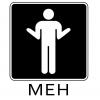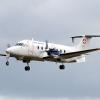I do love the eyebrows.
I believe that the way Delta used the MD-80/717 was the best way to use them. It really was a great idea, putting direct flights to smaller airports to get huge passenger numbers. By using slightly smaller looking jets, they could avoid having to use regional jets, and the MDs had enough range to get to ATL from anywhere. Even now, the 717/MD mix is getting large amounts of profit for Delta.
However, the strategy in Europe is completely different. In the US a cityhopper is inconceivable because we are such a large country with too many big cities. Also, especially on the East Coast, some cities are so close it makes no logical sense to go from one to another by plane (BOS-IAD, for example). In Europe, there are passport things that the US doesn't have between their cities that the EU does have. Also, the cities are large and kind of far between. MUC-CDG is a great example of this, large amounts of people from both countries need to fly this route for business reasons. So airlines like BA, Lufthansa, Swiss, KLM, and Air France realized this and made a cityhopping subsidiary for routes like these where higher frequencies are required. In the US, a feasible route that would be like that is New York-Chicago. We achieve this through regional jets, but in Europe you might see A320s or E-190s on this route. The jungle jet is a very good cityhopper because it is a new design with a high speed and low fuel consumption, with enough passengers to make a decent profit. So the difference is:
US: Point to point with a lower frequency and lower demand, more to connect than anything else.
EU: Point to point with a huge frequency for convenience to the passenger, they never have to wait for a flight because there's one an hour. Business meetings can easily take place.
That explains it well, I hope.
You're wrong about so many things.
There are no passport requirements inside EU+EFTA, you can cross literally all borders without a passport. Schengen area is in principle without border checks but they are not serious even for countries outside Schengen. In most cases in Schengen area you only have to present a valid ID card to airline staff to check your ticket, sometimes to security if they ask but that happens rarely (a little bit more maybe in the last few months). There are border checks in EU areas outside Schengen but you only have to take it seriously if you're non-EU national, otherwise they just take a quick glance at you ID card if they bother, and they almost never don't after they see it's a card from member states, no question asked (it's a 1-2 second OK-thanks-bye, unless you're very suspicious). But generally there's no big passport fuss in any part of inner EU borders.
There are not "too many big cities" in US, only NYC area jumps out from the size of biggest cities in Europe.
Distances are further in US, but there are also some serious distances inside EU and generally, if you don't see RJs flying LAX-JFK in US, you also won't see them flying ATH-LHR or MAD-HEL, that's very similar.
You're also wrong about frequency. To smaller cities you can see less planes in EU just like in US, no 1 h frequency if we're not talking about top 10 city combinations. And planes to big ones are usually bigger, RJs on MUC-CDG are not the main material, most of the job on such a route is done by A320 family.
I don't know what's the difference and US carriers also sometimes use smaller planes to connect even the biggest airports like JFK-ORD when schedules are good for that and they're not too distant, a quick look at FR24 and you'll see even a bunch of CRJ9s on those routes, and that's smaller than E190 we were talking about.
I don't understand what's the fascination with European "cityhoppers" because American big 3 and also smaller airlines employ dozens of their subsidiaries and also contractors to do a similar regional job...
And in the end, you didn't say one thing about what makes 717 different and better for US and E190/195 better for EU (and for the argument's sake, also no big difference with F100 or other larger RJs, or even downsized standard narrowbodies - A318 and 736). Technically they have similar performance, capacity, speed, turn time and fuel consumption (newer ones are more economical), I don't see any important difference apart from newer ones being more efficient.

 Sign In
Sign In Create Account
Create Account





 Back to top
Back to top






















